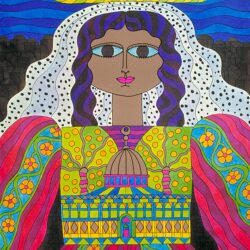Souvenirs from the wardrobe of the Arenberg family

In many ways, the family played a leading role in society. As a family of large land owners and mine owners, the Arenbergs were a strong economic actor. At other times in history, the power of this noble family was political of nature.
Throughout centuries, the Arenberg family proved to be passionate art lovers and frantically collected art that belonged to the absolute top in both size and quality. Masterpieces by Rubens, Jordaens, Veronese and Dürer will be reunited in this exhibition.

One of the eye catchers of the exhibition is undoubtedly the impressive wardrobe that the Arenberg family collected throughout the centuries; Museum M relied on the expertise of MoMu. The collection team dressed the mannequins and created tailored busts for the wardrobe.
We make custom made busts for 17 garments completely by hand. We do this with fosshape, a fairly new type of polyester that we shape around an existing model and then heat it up with steam. We then fill the new busts to suit the shape of the historical costume. It has been an unique experiment for us.
Therefore, the garments must perfectly fit the mannequins. Kim: “It not only looks nicer but adding support to delicate pieces is really necessary. We also made replicas of bale cotton of certain fragile pieces to fit the mannequins. That way, we do not have to manipulate the fragile pieces each time.”
The wardrobe

In the 1950s, Duke Engelbert Karel donated a collection of costumes to the University of Leuven that had served as a stage wardrobe in the castle of Heverelee at the end of the 19th century. The collection recalls theater as a pastime in noble circles and illustrate various aspects of the world of the Arenberg house.
Anne verbugge, curator of the exhibition and staff member of Royal Institute of Cultural Heritage and University archive KU Leuven has written a piece about the wardrobe for the publication ‘Arenberg. Portrait of a family, story of a collection’, published on the occasion of the Arenberg exhibition. 'Power and Beauty' in Museum M, Leuven, published by Brepols.
The costumes collection from Heverlee contains not only the old Brussels masquerade outfits but also more recent ones that were made for performances in Heverlee Castle. Among other things these holdings consist of authentic ducal attire, principally from the time of Louis Engelbert (1750–1820) and Prosper Louis (1775–1861). The most striking items are men’s suits, habits à la française, or parts of them, in complex silks with delicate embroidery, meant for formal occasions. There are garments that date from the ancien régime, and from the early nineteenth century, when Napoleon elevated the earlier embroidered three-piece suit – in a slightly altered shape and extravagantly decorated – to the status of court dress.

Rarer still is a late eighteenth-century ensemble of twelve still-uncut lengths of taaeta or silk satin that were intended to become the embroidered front panels, collar and buttons of a gentleman’s waistcoat. All but one are ivory-coloured, the exception being a slightly earlier piece in blue taaeta, dating from around 1760. An illustration in Diderot and d’Alembert’s Encyclopédie shows an embroiderer’s workshop with a length of silk stretched on a frame to facilitate the fine stitching. Once the embroidery was finished, the uncut fabric went to the tailor to be turned into a waistcoat or gilet with the back and lining made from cheaper fabrics. A few more mundane suits in brown, aubergine and red silk velvet (c. 1810–20) come from the wardrobe of the blind duke, Louis Engelbert of Arenberg (1750–1820), as may be seen in several portraits.
Representing female fashions are some exceptional pieces in late Empire style and from the period of the Kingdom of the Netherlands (1815–30), including an eye-catching two-piece silk tulle gown embroidered in gold thread and copper-gilt strips, a literally glittering court or wedding dress from around 1817–23. Perhaps its wearer’s partner stepped out in an equally dazzling blue coat and waistcoat lavish with gold and silver embroidery, also in the collection. A rare black silk mourning gown from the same period, although retaining the high waist of the Empire style, and with extra-long sleeves laced-up at the wrist with bows of silk ribbon, also illustrates the transition from the loose and comfortably commodious Empire gown to the romantic fashion of the 1830s with ballooning pua sleeves. An evening gown with a deep neckline and short pua sleeves in semi-transparent tulle with silk embroidery and little loops of silk-satin applied in rows (c. 1815–20) was worn with a narrower petticoat, long gloves and delicate heelless leather or satin shoes.

A couple of streamlined belle époque gowns date from the later nineteenth century, the time of Duchess Engelbert Marie, born Hedwige of Ligne (1877–1938). Finally, a number of non-European garments were also repurposed as theatrical costumes, among them North African robes in red-and-gold silk fabrics embroidered in gold and silver thread that bring to mind the women of the Algerian harem in paintings by Eugène Delacroix (1798–1863) and Lawrence Alma Tadema (1836–1912). Perhaps Hedwige of Ligne brought them back with her from Constantinople, where she had her photograph taken in 1900 wearing a similar oriental outfit. A cape and parka from the Aleutian Islands, the archipelago extending westwards from Alaska, are undeniably exotic. They and the rest of this wonderful textiles collection form a unique ensemble that evokes diverse aspects of the elitist world of the House of Arenberg. It is a little-known fact that these and other Arenberg costumes and textiles – some 250 eighteenth- and nineteenth-century items in total – are conserved and curated at Leuven University. The collection was raided whenever costumes were needed for performances staged in the private theatre at Heverlee Castle in the late nineteenth century; in 1953 the family donated the whole wardrobe to the university.




